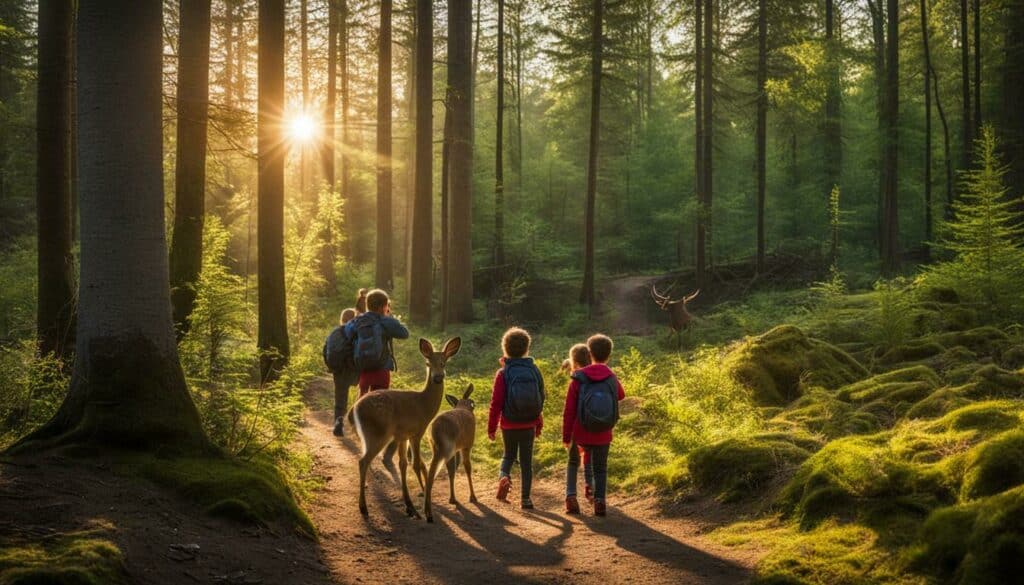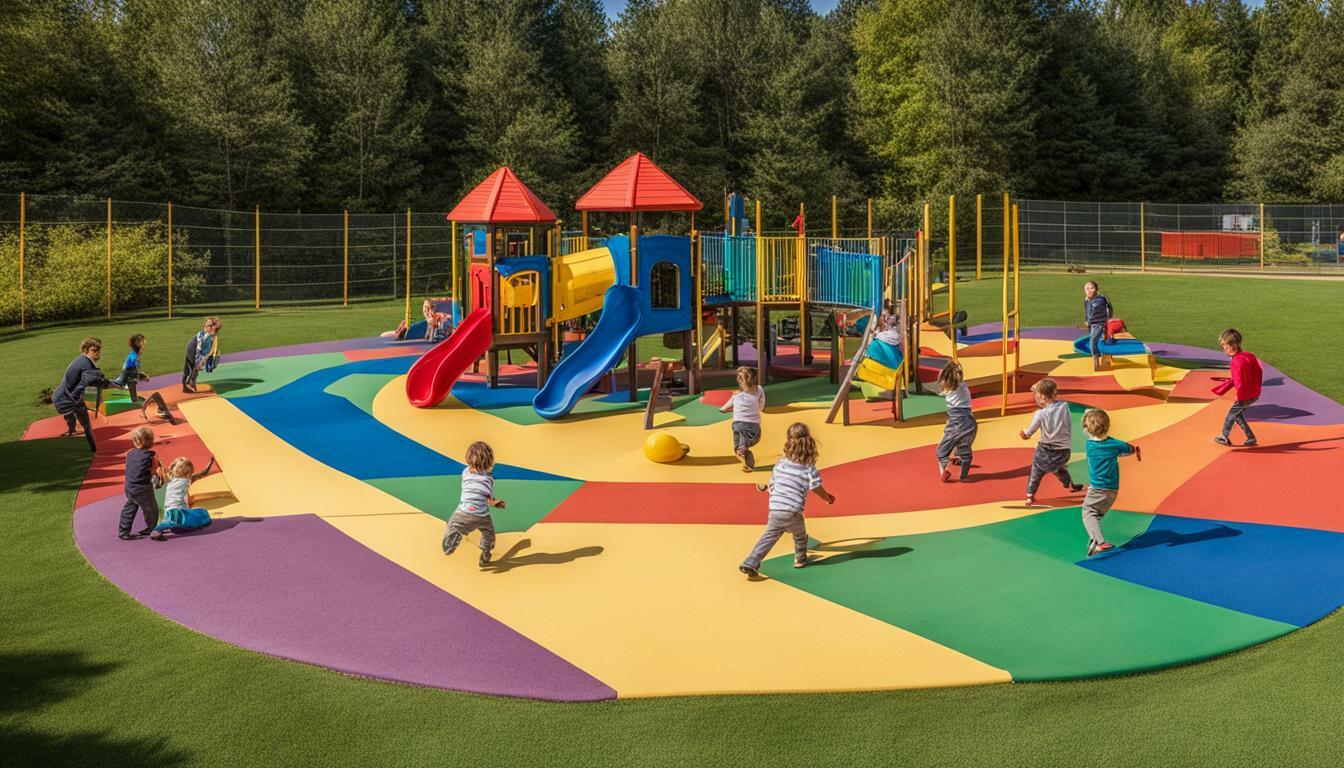When it comes to interacting safely with animals, there are several tips to keep in mind. It is important to teach children to treat animals gently and with kindness. They should never pull on an animal’s ears, tail, or feet, and should avoid wrestling roughly with animals. It is also crucial to recognize an animal’s mood and give them space when they want to be left alone. Animals should never be restrained against their will and should be treated as part of the family. Dogs should not be left outdoors chained up, as this can make them more aggressive. It is recommended to spay or neuter pets, enroll them in obedience classes, and keep their immunizations up to date. Additionally, children should avoid the face and head area when petting dogs and cats, and should avoid approaching animals that are eating, sleeping, or caring for their babies. It is important to pay attention to warning signs, such as growling or hissing, and to never approach stray or wild animals. Teaching children not to run when approached by a strange dog is essential, as running may provoke them to chase and attack. Instead, children should stand still and act like a “tree” or curl up in a ball and act like a “rock” if a dog attacks. It is also important for children to practice healthy hygiene around animals by washing their hands after contact and avoiding putting their hands or objects in their mouth while playing with pets. Finally, it is crucial to teach children about the unique behaviors of different animals and to respect their boundaries.
Key Takeaways:
- Teach children to treat animals gently and with kindness.
- Recognize an animal’s mood and give them space when they want to be left alone.
- Ensure dogs are not left chained up outdoors and are spayed/neutered, enrolled in obedience classes, and up to date on immunizations.
- Avoid approaching animals that are eating, sleeping, or caring for their babies.
- Pay attention to warning signs and never approach stray or wild animals.
Treating Animals Gently: Ensuring Safety and Awareness
When it comes to interacting safely with animals, there are several tips to keep in mind. It is important to teach children to treat animals gently and with kindness. They should never pull on an animal’s ears, tail, or feet, and should avoid wrestling roughly with animals. Treating animals gently is crucial for their well-being and safety.
Recognizing an animal’s mood and giving them space is also essential. Children should understand that animals have feelings too and may want to be left alone at times. Animals should never be restrained against their will and should be treated as part of the family.
Dogs, in particular, require special attention. They should not be left outdoors chained up, as this can make them more aggressive. It is recommended to spay or neuter pets, enroll them in obedience classes, and keep their immunizations up to date. Additionally, children should avoid the face and head area when petting dogs and cats, and should avoid approaching animals that are eating, sleeping, or caring for their babies.
To ensure safety around wild animals, it is important to pay attention to warning signs. Growling or hissing should be taken as a signal to stay away. Children should never approach stray or wild animals. If approached by a strange dog, running should be avoided as it may provoke them to chase and attack. Instead, children should stand still and act like a “tree” or curl up in a ball and act like a “rock” if a dog attacks.
Practicing healthy hygiene around animals is another crucial aspect. Children should wash their hands after contact and avoid putting their hands or objects in their mouth while playing with pets. It is also important to teach children about the unique behaviors of different animals and to respect their boundaries.

In summary:
- Treat animals gently, avoiding pulling on their ears, tail, or feet.
- Recognize an animal’s mood and give them space when needed.
- Ensure safety with dogs by spaying/neutering, obedience training, and avoiding sensitive areas.
- Stay safe around wild animals by paying attention to warning signs and avoiding approaches.
- Practice healthy hygiene by washing hands and respecting animal boundaries.
| Website | Description |
|---|---|
| www.animalsafetytips.com | A comprehensive guide to animal safety tips for kids. |
| www.humaneeducation.org | Resources for teaching kids about kindness towards animals. |
| www.aspca.org | Information on responsible pet ownership and animal safety. |
Tips for Kids Interacting Safely with Animals
When it comes to interacting safely with animals, there are several tips to keep in mind. It is important to teach children to treat animals gently and with kindness. They should never pull on an animal’s ears, tail, or feet, and should avoid wrestling roughly with animals.
Recognizing an animal’s mood is also crucial. Children should give animals space when they want to be left alone. Animals should never be restrained against their will and should be treated as part of the family.
Recognizing an Animal’s Mood and Giving Them Space
Animals, just like humans, have emotions and preferences. It is important for children to learn how to read an animal’s body language in order to understand their mood. Signs of distress can include growling, hissing, or a tense body posture. If an animal shows any of these signs, it is best to give them space and avoid interacting with them.
Teaching children to respect an animal’s boundaries is essential for their safety. They should know that animals have personal space and should not invade it without permission. Children should also be aware of the unique behaviors of different animals. For example, some animals may not enjoy being hugged or kissed, while others may love cuddles. By understanding and respecting these boundaries, children can have positive and safe interactions with animals.
| Do’s | Don’ts |
|---|---|
| Observe an animal’s body language before approaching | Approach an animal that is showing signs of aggression or fear |
| Ask the owner for permission before petting their dog or cat | Pull on an animal’s ears, tail, or feet |
| Give animals space when they want to be left alone | Restrain an animal against their will |
| Wash hands after petting animals | Put hands or objects in mouth while playing with pets |
By following these tips, children can develop a safe and respectful relationship with animals. Remember, animals are living beings that deserve our care and consideration.

Teaching children to interact safely with animals is important to their well-being and the well-being of the animals. Kids should treat animals gently, recognizing their boundaries and moods. Giving animals space and respecting their personal space is crucial. By following these tips, children can have positive and safe interactions with animals.
Safety Tips for Handling Dogs and Other Animals
When it comes to interacting safely with animals, there are several tips to keep in mind. First and foremost, it is important to teach children to treat animals gently and with kindness. They should never pull on an animal’s ears, tail, or feet, and should avoid wrestling roughly with animals. Treating animals gently is not only important for their well-being, but it also helps prevent accidents and injuries.
In addition to treating animals with care, it is crucial to recognize an animal’s mood and give them space when they want to be left alone. Animals, just like humans, have their own boundaries and preferences. It is important to respect their personal space and not restrain them against their will. By teaching children to recognize an animal’s mood and give them space, we can avoid unnecessary confrontations and ensure the safety of both the child and the animal.
When it comes to dogs specifically, there are a few additional guidelines to follow. Dogs should not be left outdoors chained up, as this can make them more aggressive. It is recommended to spay or neuter pets, enroll them in obedience classes, and keep their immunizations up to date. Additionally, children should avoid the face and head area when petting dogs and should avoid approaching dogs that are eating, sleeping, or caring for their babies. By following these safety tips, we can prevent accidents and create a safe environment for both children and dogs.
It is also important to pay attention to warning signs when it comes to interacting with animals. Growling, hissing, or other signs of aggression should never be ignored. Children should be taught to never approach stray or wild animals and to always ask for permission before petting someone else’s pet. Teaching children not to run when approached by a strange dog is essential, as running may provoke them to chase and attack. Instead, children should stand still and act like a “tree” or curl up in a ball and act like a “rock” if a dog attacks. These simple techniques can help prevent injuries and keep everyone safe.
Lastly, practicing healthy hygiene around animals is also important. Children should always wash their hands after contact with animals and avoid putting their hands or objects in their mouth while playing with pets. By practicing good hygiene, we can minimize the risk of spreading bacteria or parasites that animals may carry.
Remember, animals are our friends and deserve to be treated with care and respect. By following these safety tips and teaching children to do the same, we can ensure a positive and safe interaction between kids and animals.
| Dog Safety Guidelines |
|---|
| Teach children to treat animals gently and with kindness |
| Avoid pulling on an animal’s ears, tail, or feet |
| Recognize an animal’s mood and give them space when they want to be left alone |
| Do not leave dogs outdoors chained up |
| Spay or neuter pets, enroll them in obedience classes, and keep their immunizations up to date |
| Avoid approaching dogs that are eating, sleeping, or caring for their babies |
| Pay attention to warning signs of aggression |
| Teach children not to run from a strange dog, but to stand still or curl up in a ball if attacked |
| Practice healthy hygiene, such as washing hands after contact with animals |

“Animals are such agreeable friends – they ask no questions; they pass no criticisms.” – George Eliot
Tips for Staying Safe Around Wild Animals
When it comes to interacting safely with animals, there are several tips to keep in mind. It is important to teach children to treat animals gently and with kindness. They should never pull on an animal’s ears, tail, or feet, and should avoid wrestling roughly with animals. It is also crucial to recognize an animal’s mood and give them space when they want to be left alone. Animals should never be restrained against their will and should be treated as part of the family. Dogs should not be left outdoors chained up, as this can make them more aggressive. It is recommended to spay or neuter pets, enroll them in obedience classes, and keep their immunizations up to date. Additionally, children should avoid the face and head area when petting dogs and cats, and should avoid approaching animals that are eating, sleeping, or caring for their babies.
When it comes to staying safe around wild animals, it is important to pay attention to warning signs and to never approach stray or wild animals. Wild animals may feel threatened or scared, and approaching them can result in dangerous situations. Teaching children not to run when approached by a strange dog is essential, as running may provoke them to chase and attack. Instead, children should stand still and act like a “tree” or curl up in a ball and act like a “rock” if a dog attacks. By remaining calm and still, children can minimize the risk of harm. It is also important for children to practice healthy hygiene around animals by washing their hands after contact and avoiding putting their hands or objects in their mouth while playing with pets.
Essential Wildlife Safety Precautions
Here are some essential wildlife safety precautions to follow:
- Pay attention to warning signs such as growling, hissing, or aggressive behavior
- Avoid approaching stray or wild animals, as they may be unpredictable
- Do not run when approached by a strange dog; instead, stand still and act like a “tree”
- If a dog attacks, curl up in a ball and act like a “rock”
- Wash your hands thoroughly after contact with animals
- Avoid putting hands or objects in your mouth while playing with pets
By following these tips and precautions, children can safely interact with animals and minimize the risk of accidents or injuries.

| Animals to Avoid | Reasons |
|---|---|
| Wild or stray animals | They can be unpredictable and may carry diseases |
| Animals that are eating, sleeping, or caring for their babies | They may feel protective and territorial |
| Animals showing signs of aggression or fear | Approaching them can lead to dangerous situations |
Practicing Healthy Hygiene and Respecting Boundaries
When it comes to interacting safely with animals, there are a few key things to keep in mind. It’s not just about treating animals with kindness and respect, but also about maintaining healthy hygiene practices and understanding their boundaries.
One important aspect of healthy hygiene around animals is washing your hands after any contact. Whether you’ve been petting your furry friend or playing with them, it’s essential to thoroughly wash your hands to prevent the spread of germs. This simple habit can help keep both you and your pet healthy.
Another important aspect is avoiding the habit of putting your hands or any objects in your mouth while playing with pets. Animals, like dogs and cats, may carry bacteria in their saliva or on their fur, which can make you sick if ingested. By keeping your hands away from your mouth, you reduce the risk of potential illnesses.
Respecting animal boundaries is equally crucial. Each animal has its own unique behaviors and preferences, and it’s essential to understand and respect them. For example, some cats may not enjoy being petted for too long or in certain areas, while some dogs may not like hugs or sudden loud noises. By respecting their boundaries, you create a safer and more comfortable environment for both you and the animal.
Remember, teaching children about healthy hygiene practices and respecting animal boundaries is vital for their safety and the well-being of the animals they interact with. By instilling these habits from a young age, we can foster a culture of responsible and compassionate animal interaction.
FAQ
Q: How can I teach my children to interact safely with animals?
A: It is important to teach children to treat animals gently and with kindness. They should never pull on an animal’s ears, tail, or feet, and should avoid wrestling roughly with animals.
Q: What should my children do if an animal wants to be left alone?
A: Children should recognize an animal’s mood and give them space when they want to be left alone. Animals should never be restrained against their will and should be treated as part of the family.
Q: Are there specific safety guidelines for interacting with dogs?
A: Yes, dogs should not be left outdoors chained up, as this can make them more aggressive. It is recommended to spay or neuter pets, enroll them in obedience classes, and keep their immunizations up to date. Children should also avoid the face and head area when petting dogs and should avoid approaching dogs that are eating, sleeping, or caring for their babies.
Q: How can my children stay safe around wild animals?
A: Children should be taught to pay attention to warning signs, such as growling or hissing, and to never approach stray or wild animals. Running when approached by a strange dog should be avoided, as it may provoke them to chase and attack. Instead, children should stand still and act like a “tree” or curl up in a ball and act like a “rock” if a dog attacks.
Q: What hygiene practices should my children follow when interacting with animals?
A: Children should practice healthy hygiene around animals by washing their hands after contact and avoiding putting their hands or objects in their mouth while playing with pets. It is also important to teach children about the unique behaviors of different animals and to respect their boundaries.









